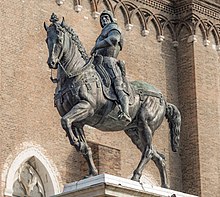Bartolomeo Colleoni
Bartolomeo Colleoni (also Coleone; * around 1400 in Solza near Bergamo ; † November 4, 1475 at Malpaga Castle in Cavernago ) near Bergamo was an Italian general condottiere of the Renaissance .
Life
Bartolomeo came from the old noble family of Colleoni from Bergamo . His first war mission was in southern Italy in 1419. There he served successively the Condottieri Braccio da Montone and Muzio Attendolo Sforza . In 1431 he went to Venice in the service of Gattamelata and fought on the side of the Serenissima against Milan until 1438 . When Gattamelata died (1443), Colleoni placed himself in the service of Niccolò Piccinino .
In 1446/47 Colleoni was imprisoned in the Monza fortress on the orders of Duke Filippo Maria Visconti . He was locked in an iron cage in which, due to the small size and the fact that the floor was paved with sharp stones, one could neither stand nor sit nor lie properly.
After the Duke died in 1447, Colleoni was released and allowed to return to Venice. The Serenissima later appointed him lieutenant general. In 1467 he was on the side of the Albizzi family who wanted to fight for their return to Florence .
When Pope Paul II called for a crusade , he wanted to see Colleoni at the head of his army, but the latter had to refuse for reasons of age. Colleoni was already honored by his hometown Bergamo during his lifetime . In 1472 Giovanni Antonio Amadeo was commissioned to build the Capella Colleoni . From 1468/69 until his death (1475) Antonio Cornazzano lived at Colleoni's castle in Malpaga to write his biography under the title Commentariorum liber de vita et gestis invictissimi bello principis Bartholomeo Colei, per Antonium Cornazzanum ad clarissimam Bergomensem Republicam .
Colleoni and his daughter Medea, who died in 1470, were buried in the Cappella Colleoni in Bergamo.
Equestrian statue
Colleoni established the Serenissima , albeit with one condition, as the heir of his considerable fortune. In his will he stipulated that the city would only get its fortune if you put your statue in front of St. Mark's Basilica . The Venetians were not very fond of the personality cult, which is shown by the fact that there are very few statues of important personalities in the city. The city saw an unparalleled affront in the demands of the Condottiere Colleoni, but they did not want to forego the general's assets, which had been stolen during his lifetime. Cunning avvocati laid the testamentary provisions made so that the Condottiere not Basilica San Marco , but the Scuola di San Marco , which is the Brotherhood next to the church San Zanipolo , in Venetian Zanipolo called, must have meant.
The sculptor Andrea del Verrocchio was commissioned to create the model. After his death (1488), the casting was carried out in 1496 by Alessandro Leopardi , who also built the stone base. The statue, one of the most famous equestrian statues of all time along with the ancient equestrian statue of Marcus Aurelius , can still be seen today on the Campo Santi Giovanni e Paolo in Venice and the city has inherited Colleoni. The Scuola di San Marco and numerous buildings connected to it now house the largest hospital in Venice. The church of San Zanipolo is the largest in the city and the resting place of doges and artists.
literature
- Dietrich Erben: Bartolomeo Colleoni. The artistic representation of a condottiere in the Quattrocento. Thorbecke, Sigmaringen 1996. ISBN 3-7995-2715-X
- Bortolo Belotti: La vita di Bartolomeo Colleoni . Istituto italiano d'arti grafiche, Bergamo 1923
- Antonio Cornazzano: Vita di Bartolomeo Colleoni . A cura di Giuliana Crevatin. Vecchiarelli, Manziana 1990, ISBN 88-85316-16-6 .
- Christian A. Isermeyer: Verrocchio and Leopardi. The equestrian statue of Colleoni. Stuttgart 1963
- Giles Knox: The Colleoni Chapel in Bergamo and the Politics of Urban Space in: Journal of the Society of Architectural Historians, Vol. 60, No. 3, pp. 290-309, California Press, 9.2001
- Michael Edward Mallett: Colleoni, Bartolomeo. In: Alberto M. Ghisalberti (Ed.): Dizionario Biografico degli Italiani (DBI). Volume 27: Collenuccio – Confortini. Istituto della Enciclopedia Italiana, Rome 1982.
- Friedrich Piel: An early portrait of Bartolomeo Colleoni, in: Art, pedagogy. Creativeness . Festschrift for Hans Daucher . Edited by Wolfgang Kehr and Ernst Rebel. Munich, Mäander Verlag, 1994. pp. 127-132. ISBN 978-3-88219-361-9 .
- Friedrich Piel: La Cappella Colleoni e il Luogo Pio della Pietà in Bergamo. In occasione del quinto centenario della morte del Condottiero. (= Monumenta Longobardica VI), Bergamo 1975
Web links
- Publications on Bartolomeo Colleoni in the Opac der Regesta Imperii
- biography
Individual evidence
- ^ Joachim Brambach: The Borgia. ISBN 3-424-01257-2 , p. 43
| personal data | |
|---|---|
| SURNAME | Colleoni, Bartolomeo |
| BRIEF DESCRIPTION | Italian condottiere |
| DATE OF BIRTH | around 1400 |
| PLACE OF BIRTH | Solza |
| DATE OF DEATH | November 4, 1475 |
| Place of death | Malpaga Castle , Cavernago |


